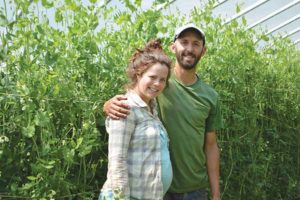 |
| Noami Brautigam and James Gagne with their ‘Super Sugar Snap’ peas at Dickey Hill Farm in mid-June |
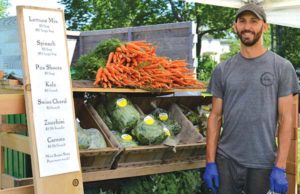 |
| The Belfast Farmers’ Market was Dickey Hill’s main sales outlet this year. |
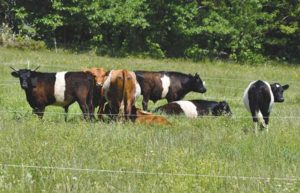 |
| A small herd of rotationally grazed beef cattle diversifies income streams for Dickey Hill and helps cycle nutrients on the farm. |
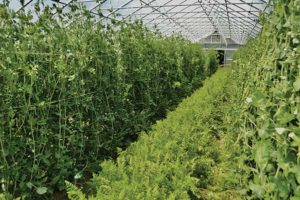 |
| Peas and carrots in a Rimol greenhouse in late spring |
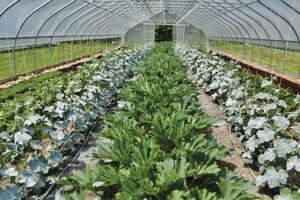 |
| Cucumbers and zucchini head for summer harvests while spring greens grow in the outer rows. |
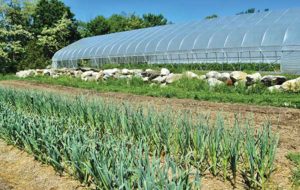 |
| Garlic grows in an outdoor bed. The plot just above the garlic was previously covered with a tarp and awaited seeding to cover crops in late spring. |
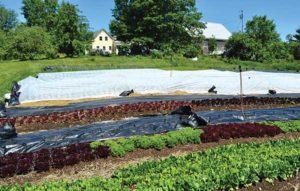 |
| Outdoor production beds, tarped beds, winter squash covered with Reemay, and the farmhouse and barn |
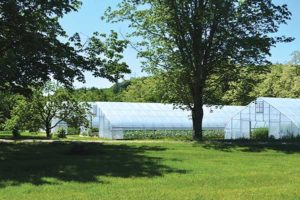 |
| The three Rimol greenhouses |
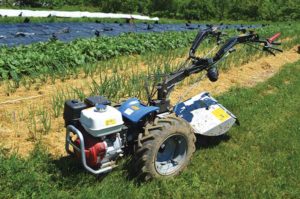 |
| Gagne and Brautigam occasionally use a BCS walk-behind tractor in their plots. |
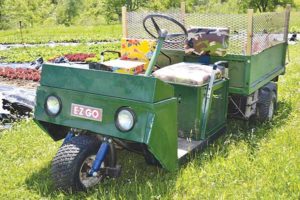 |
| A golf cart with a dump body comes in handy for moving heavy materials around the farm. |
By Jean English
Photos by the author
Dickey Hill Farm is a small, diversified, neat-as-a-pin farm on Dickey Hill Road in Monroe, Maine, operated by Noami Brautigam and James Gagne. They are inspirational for the extensive preparation they did to become farmers, the unique way in which they’re buying their farm, the infrastructure they’ve created on their farm, how they adapted their markets when COVID-19 arrived and while Brautigam was pregnant (Neta Jeanne Brautigam was born in August) and the fact that they’re now able to make a living without off-farm jobs by cultivating about half an acre of vegetables and raising a small herd of beef cattle.
Finding Farming
Brautigam grew up in Durham, New Hampshire, and first came to Maine to work at summer camps. Then one summer she apprenticed at MOFGA-certified organic Goranson Farm in Dresden, and that experience introduced her to Maine farming and to MOFGA. She followed that by growing vegetables on family land in New Hampshire and selling them at a farmers’ market. During that time she participated in MOFGA’s Journeyperson Program for a year. She then moved to Portland and worked at MOFGA-certified organic Green Spark Farm in Cape Elizabeth while also waiting tables at Eventide Oyster Company in Portland to add to her savings.
Gagne, originally from Blue Hill, worked in a variety of positions at Preble Street Veterans Housing Services in Portland and was a program manager there when he met Brautigam. Despite his limited farming experience, he and Brautigam decided to look for and start their own farm while he continued to work full-time at Preble Street.
Finding a Farm
Many people spend a couple of years or more looking for good, affordable farmland and a good farming situation. Gagne and Brautigam did not want to wait that long. They started looking while living in an apartment in Portland, and the first farm they considered (listed on Maine Farmland Trust’s FarmLink program) was affordable and viable because they were willing to navigate some land challenges there rather than spend years looking for the perfect spot.
Eric and Alison Rector had owned and tended their Monroe homestead farm for 25 years at that point and were ready for a change. Eric is a former MOFGA president, an IT consultant, a member of the Maine Cheese Guild, and he makes artisan cheese at his Monroe Cheese Studio. Alison is an accomplished painter and printmaker with studios in Monroe and Portland. They wanted to shift from homesteading and to live in a smaller house on their land. They also wanted their property to remain an organic farm, so they decided to form a limited liability company (LLC) to transition the house, barn and 18 of their acres to Brautigam and Gagne – chosen in part because of their clear business plan.
As Eric describes the process at farmsteadcooperative.org, Gagne and Brautigam would lease the property for a two-year trial period while the Rectors held all of the shares in the property. If after that Gagne and Brautigam wanted to continue farming there, they would start to purchase shares of the property from the Rectors until, after about 20 years, they would own it. The LLC agreement ensured that the land be maintained organically, and it made provisions regarding land and building maintenance and how to buy and sell shares.
So the Dickey Hill farmers settled on the Monroe land for the trial period, during which Brautigam finished her second year as a journeyperson and Gagne completed the two-year program as well. The trial period ended in March 2017, and Gagne and Brautigam then agreed to become ownership partners of the LLC, receiving their first ownership shares under the terms of a Purchase and Sale Agreement. They say that Jo Barrett, then of Land For Good, helped them through some of the decision-making for the unique land transfer process.
Gagne continued to work for Preble Street until June of 2018, directing one of its biggest programs. That off-farm income, he says, “helped with living expenses and provided income to build the farm infrastructure necessary to create a functioning, revenue-generating farm business.” In the summer of 2018, both he and Brautigam were able to farm full-time and without off-farm jobs. The years of working full-time off the farm and part-time on farm “were hard – a lot of work, with a lot of emotional and mental health costs,” says Gagne, but “in hindsight it feels like it was the right thing to do. Now we’re in a place where we really value our nonwork time and our emotional and mental health. We’re pretty intentional now about how we move forward.”
The Farm Today
Now in their sixth season of farming at Dickey Hill, Gagne and Brautigam grow MOFGA-certified organic vegetables on 40-by-100-foot plots outdoors (normally four such sections, but only two in 2020 due to the pandemic and the coming baby) and in three 30-by-96-foot unheated Rimol high tunnels (two built with partial funding from the Natural Resources Conservation Service). They start seedlings in a smaller greenhouse.
The high tunnels enable them to offer fresh, frost-sweetened greens even during the coldest months in winter. Seeding in the high tunnels for winter harvest begins as early as July and continues through early fall, allowing the plants to size up before reduced daylight limits growth. Through the coldest months of the year, they rely on the thermal mass of the soil and on a layer of 40-weight Reemay row cover to retain heat from the sun inside the high tunnels. Low wire hoops support the row cover over spinach and other low-growing crops; on taller crops such as kale, high tensile wire 3 feet off the ground supports the cover. By early June of 2020, their high tunnels were producing peas, carrots, zucchini, spinach, lettuce mix, kale, chard and pea shoots, with beets and gherkins soon to follow.
The farmers were opening two more field plots for added cultivation in 2021 by covering the ground with tarps (obtained from Paris Farmers Union) in 2020. And two of the four existing field plots were growing cover crops in 2020 – buckwheat in one bed, oats and peas in another, with a mix of vetch, rye and clover to follow in both beds over winter.
The couple also raises and sells vegetable and herb seedlings, happily taking back their seedling pots for reuse when customers return them at the market.
The vegetables grow on just over half an acre of permanent raised beds that are tilled minimally. “Most bed preparation involves a broadfork now,” says Gagne. “We use tillage to open new ground and break sod, and we do shallow tillage for seedbed preparation for direct-seeded crops – but about 90 percent of our crops are transplants.” They use their two-wheel walk-behind BCS tractor on occasion, and they use their larger tractor only for snowblowing around the greenhouses in winter, turning compost and mowing pasture – not for field work.
The crop mix is the result of two equations that they calculate at the end of each year, says Gagne: income per bed-foot for each crop and the percent of crop sold versus harvested. So, for example, while tomatoes may be a high-income crop, they are not so profitable if the farmers can sell only half their crop.
“We’ve moved away from potatoes,” says Brautigam, since they were not economical to grow in their system; and they’ve never grown broccoli or Brussels sprouts for the same reason. They also look at what other growers are offering at markets and try to fill any gaps.
These are their offerings by season:
winter – kale, collards, spinach, scallions, lettuce mix, curly parsley, cilantro
spring – lettuce, salad mix, kale, chard, bok choi, spinach, mustard greens, escarole, pea shoots, beet greens, beets, radishes, salad turnips, garlic scapes, scallions, parsley, cilantro
summer – snap peas (‘Super Sugar Snap’), cucumbers, summer squash, zucchini, green beans, eggplant, sweet and hot peppers, tomatoes, chard, kale, lettuce, salad mix, fennel, scallions, carrots (‘Mokum’ and ‘Napoli’ planted with a Jang seeder), beets, basil, parsley, cilantro, dill
fall – carrots, beets, turnips, radishes, cabbage, sweet and hot peppers, tomatoes, garlic (‘Bogatyr’ and ‘Temptress’), kale, collard greens, chard, lettuce, salad mix, spinach, winter squash, leeks, onions, parsley, cilantro
Efficient, Soil-Building, Grass-Fed Beef
Complementing the vegetable operation, Dickey Hill raises 100% grass-fed beef. The cows (eight of them currently, but they have had up to 14) graze on and enrich pasture in spring, summer and fall on part of Dickey Hill Farm’s 18 acres as well as on the Rectors’ abutting pasture. The grazing operation is not part of the LLC but is “a neighborly agreement,” says Gagne. Hay for winter feed comes from a farm in Brooks. The cows stay in or near the barn in winter; their bedding and manure eventually become compost to nourish the vegetables. (Other soil amendments include blood meal, potassium sulfate, bone char and, for seedlings, fish meal and kelp. Brautigam says they test their field plot soil annually and their high tunnel soils twice per year through the soil testing service at the University of Maine.)
They have been keeping two brood cows and raising a bull up to beef age to produce their own cows, but starting next spring they plan to buy in feeder cows rather than keep brood cows and a bull.
“We’re trying to figure out how to make grass-fed beef work on this scale,” says Gagne. “We enjoy the animals and having the compost, and it’s good to graze the pasture that abuts the farm, but we’re learning how to make raising cows economical and sustainable. The number of cows per acre depends on pasture quality and the grazing system. One of our goals is to increase the quality of the pasture so that it can support one or more animals per acre. Right now it takes 1 1/2 or 2 acres per animal. It’s a slow process.”
They started with BueLingo brood cows (not all purebred) from Quill’s End Farm and have had Belted Galloways and Herefords as well – so the herd genetics “are pretty muddy now,” says Gagne. “As we buy in feeder cows, we’ll buy from folks who probably have Angus Hereford cross animals.”
Meanwhile, the Rectors built and now live in their smaller house up the hill. Eric still uses the commercial kitchen in the barn to make cheese, and he helps tend the impressive home orchard that he and Alison planted.
Markets
Until 2020 Gagne and Brautigam sold at the Rockland Farmers’ Market one day per week in summer and at the Belfast Farmers’ Market year round. In 2020 they took the season off from the Rockland market because of the pandemic and the pregnancy. They intend to return to that market in 2021.
Like many farmers facing the pandemic, they started taking orders online at www.dickeyhillfarm.com/online-store through Squarespace before the market each week to streamline sales, to reduce the need for in-person financial transactions and to minimize contact with customers and food. Brautigam says the platform is very affordable and very user-friendly for customers but somewhat challenging for the farmers on the back end (regarding printing orders, reports, etc.). As summer progressed, they added bagged produce to their farmers’ market booth as more was available. They also grew fewer of the large, soft heirloom tomatoes, since they wouldn’t hold up well when bagged.
They do a little wholesaling – less than 5% of their business – when they have surplus to sell and someone has a need. “It takes a lot of coordination to line up wholesale accounts and to do the crop planning for wholesaling,” says Gagne. “It doesn’t work well on our scale. We did more when we started – wholesaling, a CSA, farmers’ markets.” They found over time that selling directly at farmers’ markets works best for them and enables them to manage their anxiety.
Continuing Education
Gagne and Brautigam are among the first cohort of MOFGA’s Maine Farm Resilience Program, which provides individualized support to advanced-beginning farmers (those with five to nine years of experience) to help them scale up; access and adapt to new markets; manage risk, innovation and diversification; and strategize new business plans to achieve long-term farm viability. The program matches participants with experienced mentors and service providers; offers a series of six seminars to help support participants’ goals; helps participants develop a farm action plan; and offers a stipend totaling $3,500 to access advanced educational opportunities as well as technical, professional and pivot point services.
“We used our first chunk of money,” says Gagne, “to hire Steve Sinisi of Old Crow Ranch [in Durham, Maine] to consult about our beef herd. The next phase – long-term business planning – is on hold because of corona. Our goals for last February, March and April were to dial in on our 5-, 10- and 20-year plans for the farm. The courses through the Maine Farm Resilience Program were leading us to that point. Then the pandemic hit and redirected our planning. What we hope to get out of the program is to fine-tune the business rather than our growing practices. We’re in a place now where we like our markets and growing practices. How do we fine-tune all those elements to maximize our capacity? We’re looking forward to chowing down on that this year,” their second year in the program.
Brautigam adds that they hired someone to work on the farm two days per week last year. They had planned to hire two people to work part-time for a total of 40 hours per week in 2020, but ended up doing all of the farming themselves – again because of the pandemic. In the future, “We are moving in the direction of hiring more employees and figuring out the right balance of labor,” she explains. Should they scale up the year-round production for the Belfast market? How could they hire someone who would be available to harvest winter greens on short notice, when the sun is going to be out for a few hours on a particular day that week? These – as well as figuring out how to save for retirement – are among the questions they plan to address as they continue to build the resilience of their farm.
